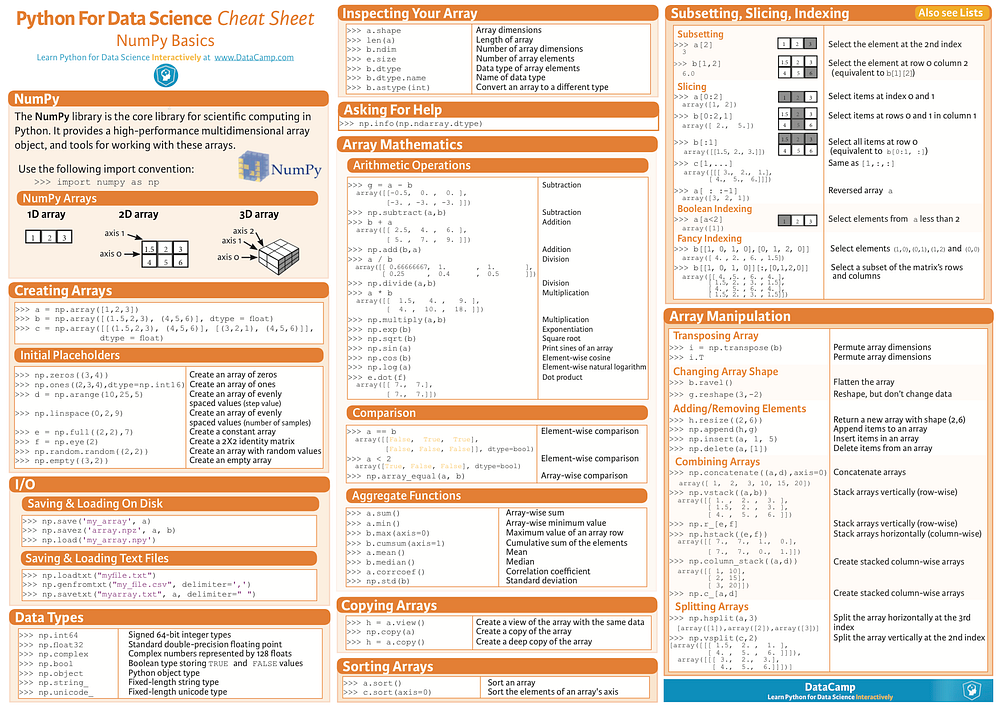NumPy Library
(Redirected from Numpy)
Jump to navigation
Jump to search
A NumPy Library is a Python-based numerical analysis library.
- Context:
- It can support a NumPy Data Structure, such as a numpy.ndarray and a numpy matrix.
- It can support a NumPy Function, such as numpy.transpose, numpy.linalg, ...
- ...
- Example(s):
- NumPy, v2.0.0 (~2024-06-05) [1].
- NumPy, v1.26.4 (~2024-06-05) [2].
- NumPy, v1.12.1 (~2017-03-05).
- NumPy, v1.3.0 (~2008-11-27).
https://github.com/numpy/numpy/releases.- …
- Counter-Example(s):
- See: NumPy Vectorization, NumPy Broadcasting, Indexing Operation, Interpolation Function, Matrix Decomposition, Eigenvalue Computation, Systems of Equations Solving, Matrix Inversion.
References
2017a
- (Wikipedia, 2017) ⇒ https://en.wikipedia.org/wiki/NumPy Retrieved:2017-6-5.
- NumPy (pronounced () or sometimes ()) is a library for the Python programming language, adding support for large, multi-dimensional arrays and matrices, along with a large collection of high-level mathematical functions to operate on these arrays. The ancestor of NumPy, Numeric, was originally created by Jim Hugunin with contributions from several other developers. In 2005, Travis Oliphant created NumPy by incorporating features of the competing Numarray into Numeric, with extensive modifications. NumPy is open-source software and has many contributors.
2017b
2014
- http://numpy.org/
- NumPy is the fundamental package for scientific computing with Python. It contains among other things:
- a powerful N-dimensional array object.
- sophisticated (broadcasting) functions
- tools for integrating C/C++ and Fortran code.
- useful linear algebra, Fourier transform, and random number capabilities
- Besides its obvious scientific uses, NumPy can also be used as an efficient multi-dimensional container of generic data. Arbitrary data-types can be defined. This allows NumPy to seamlessly and speedily integrate with a wide variety of databases.
Numpy is licensed under the BSD license, enabling reuse with few restrictions.
- NumPy is the fundamental package for scientific computing with Python. It contains among other things:
2014b
- http://wiki.scipy.org/NumPy_for_Matlab_Users
- In NumPy the basic type is a multidimensional array. Operations on these arrays in all dimensionalities including 2D are elementwise operations. However, there is a special
matrixtype for doing linear algebra, which is just a subclass of thearrayclass. Operations on matrix-class arrays are linear algebra operations. - Python uses 0 (zero) based indexing. The initial element of a sequence is found using a[0].
- NumPy is based on Python, which was designed from the outset to be an excellent general-purpose programming language. While Matlab's syntax for some array manipulations is more compact than NumPy's, NumPy (by virtue of being an add-on to Python) can do many things that Matlab just cannot, for instance subclassing the main array type to do both array and matrix math cleanly.
- In NumPy arrays have pass-by-reference semantics. Slice operations are views into an array.
- NumPy code is Python code, so it has no such restrictions. You can define functions wherever you like.
- NumPy does not have one standard IDE. However, the IPython environment provides a sophisticated command prompt with full completion, help, and debugging support, and interfaces with the Matplotlib library for plotting and the Emacs/XEmacs editors.
- In NumPy the basic type is a multidimensional array. Operations on these arrays in all dimensionalities including 2D are elementwise operations. However, there is a special
